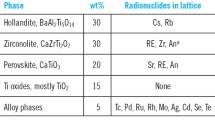Abstract
A ceramic waste form is being developed by Argonne National Laboratory* (ANL) as part of the demonstration of the electrometallurgical treatment of spent nuclear fuel [1]. The halide, alkaline earth, alkali, transuranic, and rare earth fission products are stabilized in zeolite which is combined with glass and processed in a hot isostatic press (HIP) to form a ceramic composite. The mineral sodalite is formed in the HIP from the zeolite precursor. The process, from starting materials to final product, is relatively simple. An overview of the processing operations is given. The metrics that have been developed to measure the success or completion of processing operations are developed and discussed. The impact of variability in processing metrics on the durability of the final product is presented. The process is demonstrated to be robust for the type and range of operation metrics considered and the performance metric (PCT durability test) against which the operation metrics are evaluated.
Similar content being viewed by others
References
U.S. Department of Energy, ‘Draft Environmental Assessment-Electrometallurgical Treatment Research Demonstration Project in the Fuel Conditioning Facility at Argonne National Laboratory-West,’ DOEIEA-1148, Department of Energy, Washington, DC, (1996).
Technical Strategy for the Management of INEEL Spent Nuclear Fuel, Volume I, A report of the INEEL Spent Nuclear Fuel Task Team, prepared for DOE Office of Spent Fuel Management, (1997).
K.M. Goff, M.F. Simpson, S.G. Johnson, K.J. Bateman, T.J. Battisti, and S.M. Frank, in Proceedings of the Third Topical Meeting on DOE Spent Nuclear Fuel and Fissile Materials Management, (American Nuclear Society, Illinois, 1998).
S.K. MacLeod, Analytical Chemistry 63 (10), 557–566 (1991).
Standard Test Methods for Determining Chemical Durability of Nuclear Waste Glasses: The Product Consistency Test, ASTM C1285-94, American Society for Testing and Materials, Philadelphia, PA (1995).
Strachan, D.M., R.P. Turcotte, and B.O. Barnes, ‘MCC-1: A Standard Leach Test for Nuclear Waste Forms,’ Workshop on comparative leaching behavior of radioactive waste forms, Argonne, IL (1980).
Bates, J.K., and T.J. Gerding, in The Scientific Basis for Nuclear Waste Management VIII, edited by C.M. Jantzen, J.A. Stone, and R.C. Ewing (Mater. Res. Soc. Proc. 44, Pittsburgh, PA, 1985) pp. 295–302.
Luo, J. S., et al., in The Scientific Basis for Nuclear Waste Management XX, edited by W.J. Gray and I.R. Triay (Mater. Res. Soc. Proc. 465, Pittsburgh, PA, 1997) pp. 157–163.
Author information
Authors and Affiliations
Rights and permissions
About this article
Cite this article
Esh, D.W., Goff, K.M., Hirsche, K.T. et al. Development of a Ceramic Waste Form for High-Level Waste Disposal. MRS Online Proceedings Library 556, 107 (1998). https://doi.org/10.1557/PROC-556-107
Published:
DOI: https://doi.org/10.1557/PROC-556-107




